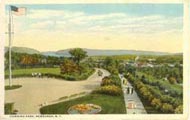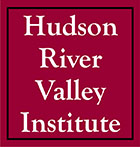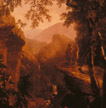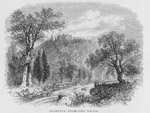 Web Content Display
Web Content Display
The Pre-Civil War Era (1840-1865)
 Web Content Display
Web Content Display
The Pre-Civil War Era (1840-1865)
Neil Larson, Larson Fisher Associates
Romanticism and the Picturesque
The enduring popular image of the Hudson Valley as a sublime Acadian landscape was created by Romantic artists during the Pre-Civil War or Antebellum Era (1840-1865). For architecture, the idea of Picturesque characterizes this vision, where buildings were designed and settings were composed as if to be viewed through a frame and appreciated as a work of art. This was an intellectualized conception of architecture and the landscape that was developed by artists and writers in New York City. They Romanticized the beautiful aspects of the landscapes of the Hudson River and Catskill Mountains to assuage their disappointment with the vulgar excesses of the urban lifestyle. They are considered Romantics because they desired to return to a more primitive natural state and attempted to do so in painting, literature, poetry and architecture. They energetically sought out these natural conditions, hiking and exploring the river and mountains for picturesque locales that they would capture in paint or words. Through this art, the Hudson Valley became known around the world, and the region became a source of incredible art. Another dimension of this fascination with the Hudson Valley scenery is that the region had become increasingly connected to the city. The Hudson River Rail Road was completed in 1850 and made every part of the valley accessible to New York within a matter of hours.
 View of Hudson Highlands from Cornwall, oil on canvas, c1850, artist unknown.
View of Hudson Highlands from Cornwall, oil on canvas, c1850, artist unknown.
Andrew Jackson Downing, Father of the Hudson Valley Romantic Landscape
All the attention the region received motivated a movement for community renewal. Architects responded with new designs prompted by Romantic revivals of "natural" architecture. The rigid styles from antiquity were rejected, as well as the white-painted farmhouses they had inspired. More organic architectural models were adopted, notably those following Gothic and Renaissance themes. Artificial formality was removed from domestic and public landscapes to make them appear more natural and picturesque. Much of this transformation can be credited to Andrew Jackson Downing, son of a Newburgh nurseryman, who after a visit to England set out to civilize the Hudson Valley landscape. A prolific writer, Downing nearly single-handedly popularized the new Picturesque taste. He had few actual projects to his credit; however, through his articles and books, he was tremendously influential. Tragically, he died in a steamboat wreck in 1852, but his legacy is still strongly evident in the region.
 View and plan of Highland Garden, home of A.J. Downing, Newburgh, N.Y. (1838).
View and plan of Highland Garden, home of A.J. Downing, Newburgh, N.Y. (1838).
Gothic Revival Architecture
Perhaps the most conspicuous element of Picturesque architecture in the Hudson Valley is the pointed Gothic gable ornamented with verge boards. It was applied to a wide range of building types; however, it is most fully represented in the Gothic cottage promoted by Downing as an appropriate design for a small house. This was by no means an American invention, rather one Downing adopted directly from English architecture. (The American Romantics relied heavily on models from England where Romanticism was well established in the arts and literature.) The Gothic style was popular in England because it was considered an indigenous architecture unlike the architecture inspired by the Italian Renaissance that had dominated popular taste there during the 17th and 18th centuries. This was a native distinction that pleased the English Romantics, and Britain experienced an extensive revival of the Gothic taste. They also revived popular interest in the English countryside and the barren landscapes of Yorkshire, Wales and Scotland. Poets such as Yeats, Wordsworth and Shelly roamed these parts and wrote reams of verse inspired by it. Novelists like Walter Scott created historical tales that glorified the Medieval English past, which the public avidly read in serial form. Scott lived in a castle near Edinburgh. He was visited by Washington Irving, who modeled his writing style after English writers including Scott, and the American returned to Tarrytown and built his cozy Dutch cottage at Sunnyside, which was really a Gothic house with stepped gables like Scott's own Abbotsford. In practice American Romanticism was an English product.
 View of the Delamater House, Rhinebeck, Dutchess County, 1844, Alexander Jackson Davis, architect. Photograph by Neil Larson.
View of the Delamater House, Rhinebeck, Dutchess County, 1844, Alexander Jackson Davis, architect. Photograph by Neil Larson.
 Woodcut view of Washington Irving's Sunnyside.
Woodcut view of Washington Irving's Sunnyside.
Washington Irving was instrumental in the dissemination of the Romantic taste and Picturesque imagery. His Dutch tales recalled a simpler, more primitive time as much as a landscape painting. In his tale of Rip Van Winkle, Irving introduced the world to the Catskill Mountains. He is credited with initiating tourism in the region by creating seemingly real locales that people set out to find. Numerous places in the mountains vied to be the setting for parts of the story, and entrepreneurs built hotels and refreshment stands to lure tourists and turn a profit. Thus, the Gothic Revival in the Hudson Valley had substantial doses of old New York Knickerbocker mixed in, even though it had very little to do with Dutch architecture.
Italianate Architecture
Yet, the Picturesque architecture of the Hudson Valley was not limited to English Gothic sources. Italian villas were another favorite model. Sojourns to Italy had inspired artists and architects in every generation since the Renaissance, and the 19th-century Romantics were no exception. The Italian countryside epitomized the Picturesque. The Italian country house, or villa form was compelling for its antiquity and natural materials. It was appreciated by architects because of its asymmetrical, organic forms and plans. In their desire to break up the Classical box house form, they incorporated the irregular features of the Italian villa into all modern house types from large houses to small. More than any other prototype, the villa influenced large house and country house architecture in the region. The horizontal roofline of the Italian villa, in contradistinction to the pointed ness of the Gothic cottage, its broad overhangs and bracketed cornices, and round-headed windows were grafted onto more modest village and farm houses just as Gothic elements were. Both continue to be conspicuous in towns along the entire course of the Hudson River.
 View of a house in the "Italian style," Kinderhook, Columbia County. Photograph by Neil Larson.
View of a house in the "Italian style," Kinderhook, Columbia County. Photograph by Neil Larson.
Improving Domestic Space
While there was nothing particularly innovative in the revival of antique house designs, when Downing rearranged the conventional rectangular floor plan, removed vestigial spaces and broke with outdated room uses, he revolutionized domestic space. The plans of his houses were simplified yet interesting and they catered to new trends in the middle-class lifestyle. Living rooms with bay windows, dining rooms connected to kitchens, clothes and water closets and wide, wrap-around piazzas on the exterior to bridge the traditional gap between indoor and outdoor space. Downing's prescription for progressive living would be the beginning of a long history of American design and literature focused on domestic space. It occurred in this era because American lifestyles were changing as more and more people were moving from farm to town occupations and transforming small-town life. The popular literature for domestic improvement was initiated by Andrew Jackson Downing, but he likely already sensed the tremendous demand for it.
While many cottages and villas were built to Downing's specifications, many more houses of traditional designs were embellished with pointed gables, verge boards and ornamented cornices and porches that were inspired by the examples found in his publications as well as the proliferating numbers of pattern book coming into circulation. Houses large and small, located in cities, in villages or on farms, all began to display the softening effects of Picturesque design. So did barns, factories and schools, as well as churches, train stations, and town halls. The Hudson Valley was the source of American Romanticism and it soon became the best expression of it. Of course this architectural transformation essentially marked the end of the long rural vernacular tradition introduced in the Colonial Era. These older houses remained in use and many of them have been preserved to this day, but no more were built in that fashion by this period. Timber framing was supplanted by balloon construction using standard dimension lumber imported from other parts of the state and nation. Gone were the days of felling trees and hewing beams in the woods, hauling them to the house site and erecting them in a frame assembled with mortise and tenon joints. Carpenters were trained in other methods, and economy of materials and labor was critical to keeping the house affordable. (All of A.J. Downing's sample houses were given a cost so that readers could determine what they could reasonably afford.) Housing and the society had finally emerged from the influence of pioneer days and people were looking forward instead of back.
 View of St. Philip's Episcopal Church, Highland Falls, Orange County, Robert Weir, architect. Photograph by Neil Larson.
View of St. Philip's Episcopal Church, Highland Falls, Orange County, Robert Weir, architect. Photograph by Neil Larson.
 View of Railroad Station, Peekskill, Westchester County. Photograph by Neil Larson.
View of Railroad Station, Peekskill, Westchester County. Photograph by Neil Larson.
 View of Lorzel's Brewery, Saugerties, Ulster County. Photograph by Neil Larson.
View of Lorzel's Brewery, Saugerties, Ulster County. Photograph by Neil Larson.
Landscape Design
For Downing and other Romantics, the landscape was as important as the house in the design of domestic space. His first book was titled, Landscape Gardening and Rural Architecture. He was as particular about the design and organization of the house's landscape as he was about the interior. In both cases, the informal naturalness of the arrangement was the critical factor. In a sense, he created and arranged spaces (rooms) in the landscape to function in the same domestic manner as the house. Gardens, lawns, orchards, rustic areas, ponds and fountains, flower beds, paths, specimen trees, were all components to accommodate within the topography of the site and enhance the setting of the house. Views from one part of the landscape to another and vistas to scenery outside the landscape were fundamental to the Picturesque design. At each vantage point, the view was meant to compose a pleasing picture where nature and domesticity were in harmony. This taste indicated the affluence and literacy of Downing's readership. In fact, one had to be literate to absorb this information from a book, but one also had to educated enough to read the complex architectural and landscape vocabulary and to be familiar with its historic and literary sources to appreciate the Picturesque idea from which it sprang. Downing counted on the literacy and upward mobility of his clientele to respond favorably to his sermons on improvement.
 Plan of a landscape for a house, from A.J. Downing, Treatise on Landscape Gardening (1841).
Plan of a landscape for a house, from A.J. Downing, Treatise on Landscape Gardening (1841).
Public Parks
As a result of the reputation he gained from his books and treatises on landscape gardening, Andrew Jackson Downing was awarded the commission to develop the landscape plan for the mall in Washington, D.C. This was one of the first formal landscape plans in America, and it initiated a period where public spaces and parks received the attention of specialized designers. Following his death in 1852, Downing's leadership role was assumed by Frederick Law Olmsted of Boston, who is considered to be the "father" of American landscape architecture. Olmsted planned parks, parkways and suburbs throughout the country, including New York's Central Park, which he designed with Downing's protégé Calvert Vaux in 1858. Olmsted and Vaux designed other parks in the region including Washington Park in Albany and Downing Park in Newburgh, which they dedicated to the memory of their mentor. Parks were important civic projects in the region in this period in cities and villages alike to improve the appearance of town centers and major streets, recover wetlands or polluted areas, and create amenities for residents. Cemeteries were improved and designed like parks, and the public would stroll or ride through the landscapes and sculptural monuments for recreation.
 Post card image of Downing Park, Newburgh, Orange County.
Post card image of Downing Park, Newburgh, Orange County.
 View of Albany Rural Cemetery, Menands, Albany County. Photograph by Neil Larson.
View of Albany Rural Cemetery, Menands, Albany County. Photograph by Neil Larson.
The Birth of the Suburbs
It was during this period that the idea of the American suburb was introduced, and the Hudson Valley contains some of the earliest suburban developments in the nation. Andrew Jackson Downing's promotion of the detached single-family house and landscape as the ideal domestic environment was a harbinger of the suburban movement. Within the Romantic image of the independent family house and its setting was an implicit condemnation of the industrial city. The growing middle class in cities and villages throughout the region, who were able to afford these new houses, were also looking for opportunities to relocate to that "border land" outside the built-up part of the town but not in the remote countryside. Transportation improvements, notably the railroad, made it possible for people to work in town and live in a more natural setting. In reaction to a grid development plan proposed in Irvington, New York Downing published a plan for an ideal "country village" in 1850 with detached houses on tree-lined streets surrounding a public park. Like his other designs, it was based heavily on English prototypes. Llewellyn Park in Orange, New Jersey is considered to be the first planned suburb in America. Opened in 1857, it was designed by Llewellyn S. Haskell, the developed, and architect Alexander Jackson Davis.
Planned developments such as Llewellyn Park were rare in the Pre-Civil War Era. What was more common in the region was the general suburbanization of fringe areas of existing cities and villages. The access roads leading north and south from towns along the Hudson River were prime locations for the "suburban seats" of merchants and professionals associated with them. On the east side of the river, the hillsides became dotted with elegant villas and cottages along the Albany Post Road (now U.S. Route 9). Many old Colonial- and Federal-era estates adjacent to expanding cities were subdivided by heirs and lots sold to middle-class families. A whole new real estate market was born. Development along the west side of the river was restricted by the Palisades and the Highlands and hampered by the absence of a rail connection; however, the towns north of that barrier experienced similar suburban growth along the riverfront. Newburgh was a special garden spot due to the direct influence of A.J. Downing and his legacy. An extensive suburb developed north of the city in Balmville. Nathaniel Parker Willis, a popular Romantic writer of the day, built a Gothic cottage and landscape south of town, called Idlewild, that was widely published. By the time of the Civil War, suburbanization was well underway along the entire navigable extent of the Hudson River from New York City to Albany. It would continue and grow even greater after the interruption of the Civil War. In fact it would never end. Suburbanization is the blessing and curse of life in the Hudson Valley to this day.
 View of house in Balmville, Orange County, Frederick Clarke Withers, architect. Photograph by Neil Larson.
View of house in Balmville, Orange County, Frederick Clarke Withers, architect. Photograph by Neil Larson.
Hudson Valley Tourism
Rail service in the region was improved when the West Shore Railroad was completed in the late 1850's and spawned connecting routes west into the Catskills and beyond. With this event, the extent of tourism multiplied, and it had a tremendous impact on architecture in the region. Hotels large and small, boarding houses and tourist homes popped up along the river, in the Highlands, and in the Catskills to accommodate the streams of city dwellers seeking the temporary respite of the country. Farm families bolstered their income by taking in summer boarders seeking more economical and informal room and board. It was a democratic experience; rich and poor, native and immigrant, artist and sportsman, recluse and recreationist all had a place to go to find solace and renewal in nature. Tourism would continue to expand after the Civil War and peak in the early 20th century reflecting the continued growth and scope of the New York City urban experience.
 Parry House Hotel, Highland Falls, Orange County, lithograph.
Parry House Hotel, Highland Falls, Orange County, lithograph.
 Small Catskills hotel, Delaware County. Photograph by Neil Larson.
Small Catskills hotel, Delaware County. Photograph by Neil Larson.
 Van Benschoten Guest House, Margaretville, Delaware County. Photograph by Neil Larson.
Van Benschoten Guest House, Margaretville, Delaware County. Photograph by Neil Larson.
The Civil War and the End of Romanticism
The Civil War clearly did not bring an end to growth and development in the Hudson Valley. In reality, it was merely an interruption in a burgeoning expansion that would not culminate until a century later. But, the region did have one significant casualty of Civil War: Romanticism. Idealism fares badly in war situations and the Civil War was no exception. Although the effort to preserve the union was victorious, the loss of life and terrible experiences dampened optimism for a better world. Historians use the war as a watershed for a maturing of the American persona, and while it is evident that whatever sense of innocence was left in the culture was lost, the effect was more about fatalism than maturity. It is well known that the war solidified the power of capitalists and opportunists. However, the event coincided with a tremendous growth of industrialization and immigration that altered the economy and demography of the region in extraordinary ways. The Hudson Valley witnessed a radical transformation, yet again. It would emerge from the Civil War a much different place.
Selected Reading
Downing, Andrew Jackson. Landscape Gardening and Rural Architecture. 1865; rpt NY: Dover, 1991.
Fishman, Robert. Bourgeois Utopias, The Rise and Fall of Suburbia. NY: Basic Books, 1987.
Schuyler, David. "The Sanctified Landscape: The Hudson River Valley, 1820-1850." Landscape in America. George F. Thompson, ed. pp 93-109. Austin: University of Texas Press: 1995.
Stilgoe, John. Borderlands: Origins of the American Suburb, 1820-1935. New Haven: Yale University Press, 1988.
Sweeting, Adam. Reading Houses and Building Books, Andrew Jackson Downing and the Architecture of Popular Antebellum Literature, 1835-1855. Hanover NH: University Press of New England, 1996.
Zukowsky, John and Robbe Pierce Stimson. Hudson River Villas. NY: Rizzoli, 1985.

 "View the grounds in Blithewood, Dutchess Co., N.Y." From A.J. Downing, Treatise on Landscape Gardening (1841).
"View the grounds in Blithewood, Dutchess Co., N.Y." From A.J. Downing, Treatise on Landscape Gardening (1841). Kindred Spirits, oil on canvas, painted by Asher B. Durand. New York Public Library Collection. The painting pictures Kaaterskill Falls in the background. The two figures are the painter Thomas Cole and the poet William Cullen Bryant.
Kindred Spirits, oil on canvas, painted by Asher B. Durand. New York Public Library Collection. The painting pictures Kaaterskill Falls in the background. The two figures are the painter Thomas Cole and the poet William Cullen Bryant. Illustration of "A Villa in the Italian Style" from A.J. Downing, The Architecture of Country Houses (1850).
Illustration of "A Villa in the Italian Style" from A.J. Downing, The Architecture of Country Houses (1850). View and plan of "An Irregular Cottage in the Old English Style," from The Architecture of Country Houses (1850).
View and plan of "An Irregular Cottage in the Old English Style," from The Architecture of Country Houses (1850). View of 18th-century stone house with a Gothic cross gable, Hyde Park, Dutchess County. Photograph by Neil Larson.
View of 18th-century stone house with a Gothic cross gable, Hyde Park, Dutchess County. Photograph by Neil Larson. Plan of Llewellyn Park (1857). From Henry Winthrop Sargent, "Supplement to the Sixth edition of Landscape Gardening (1865).
Plan of Llewellyn Park (1857). From Henry Winthrop Sargent, "Supplement to the Sixth edition of Landscape Gardening (1865). Detail of Wade & Croome's Panorama of the Hudson River (1848) showing Hastings-on-Hudson, Westchester County. From "A Hudson River Portfolio," New York Public Library Digital Collection
Detail of Wade & Croome's Panorama of the Hudson River (1848) showing Hastings-on-Hudson, Westchester County. From "A Hudson River Portfolio," New York Public Library Digital Collection View of Idlewild, Cornwall, Orange County, wood engraving. From Benson Lossing, The Hudson, From the Wilderness to the Sea (1866).
View of Idlewild, Cornwall, Orange County, wood engraving. From Benson Lossing, The Hudson, From the Wilderness to the Sea (1866).



